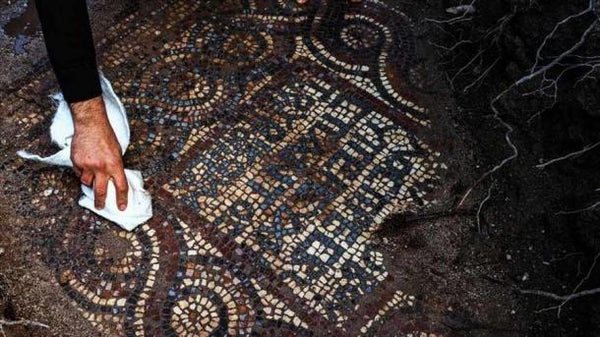For mosaic art enthusiasts, this is already an outstanding year for mosaic discoveries. Our favorite art medium is still generating surprises, as with the latest archaeological finds in Turkey.
As you’ve discovered in previous articles, this region is home to some of the most significant and plentiful mosaic art examples from history. (We rank the Zeuman Mosaic Art Museum in Gaziantep as a Top Vacation Destination!)
These latest announcements are big ones – one adding new layers of meaning to Bronze Age mosaic styles, and the other causing jaws to drop with sheer beauty. Here’s what you need to know.
Record-Setting Mosaic Finds from Anatolia
When headlines refer to the “World’s Oldest”, it’s sometimes a bit of an exaggeration. Not so in Central Turkey, where archaeologists believe they’ve uncovered the oldest mosaic yet. In Uşaklı Höyük, a temple excavation ended up yielding far more information about the Hittite culture than expected, as a mosaic floor emerged in a nearby courtyard. Surprised archaeologists found that it was paved with more than 3,000 pieces of shaped and cut stones, placed into geometric patterns.

As reported by Anacleto D’Agostino of the University of Pisa, this find indicates that it was probably associated with the Hittite Storm God, and was located in an area that held “high status” architecture. The location of the mosaic is indicated in yellow below, inside the larger temple site.

The prehistoric mosaic deviates from other ancient examples with its complexity. Expect more finds from this location, which D’Agostino thinks may have been the legendary city Zippalanda.
Although archaeologists are still piecing together the story behind this, and other clues at the Uşaklı Höyük site, they see evidence of well-organized ancient civilizations, active trade and travel between the communities, and an impressively large central temple dedicated to worship of the Storm God. Like many ancient deities, he never really disappeared, merely transforming into other deities as cultures intermixed and assimilated various groups.

Interestingly, this type of geometric mosaic design can be seen in the floors and mosaic tile installations of the more recent Middle Eastern temples, for example. It’s rather amazing to think that our modern floor tile preferences can be traced back to the ancient Hittites of the Late Bronze Age of 1650–1200 BC.
Maybe this is why some of Mozaico’s top-selling designs for modern homes are geometric?
Reclaimed From Thieves, a Byzantine Site Reveals Treasures
In Izmir, another Anatolian province in Turkey, a couple of would-be thieves made the news in 2021. In this case, they inadvertently introduced another extraordinary example of mosaic art to the world. Byzantine relics are another key part of mosaic art history, During the time of the Byzantine Empire that ranged from the 6th to the 15th century, mosaics were one of the most popular forms of artwork to be displayed in places of religious worship.
As a connoisseur of fine mosaic art, you’ve doubtless admired examples of these icons in museums, churches, or even brought them into your own home. They range from strongly geometric designs to masterpieces of light and tile placement.


This important find was literally uncovered this April, as authorities were tipped off to illegal excavation activity. After securing the area, they were astonished that a previously unknown Roman monastery was buried in the remote and mountainous Aliağa region.

Although the site is very new and a team from the Izmir Archeology Museum is actively working on the excavation at the time of this blog, they’ve determined that the facility was likely occupied between the 4th and 14th centuries. This section of floor has been determined to be approximately 1,500 years old.
Deemed a “universal cultural asset and a rare artifact”, the initial floor section will be removed to the Museum for further study. The newly unearthed monastery was sizable, even containing a basilica. Even at this early stage, we can anticipate many exciting finds from this site. Its isolated location has undoubtedly helped preserve much more mosaic art.

The toughness, longevity, and durability of mosaic art have always preserved history, continued to tell stories, and commemorate the beginning of new ones. Even today, we can create our own tales with custom mosaic art, carefully curated mosaic design choices for our homes, and mosaic art selections that capture our personal interests.
It begs the question: When the unknown Hittite artists were carefully placing their stones near their Storm God temple, or the gentle monks at the Aliağa monastery laid out the patterns of their floors, what did they want to share with the world? What did they want to leave for future generations? What Mozaico design would best represent you?
Check out our extensive online catalog to find your perfect match, and subscribe to our free newsletter to help guide you through the latest inspiration and updates from the world of mosaic art!





